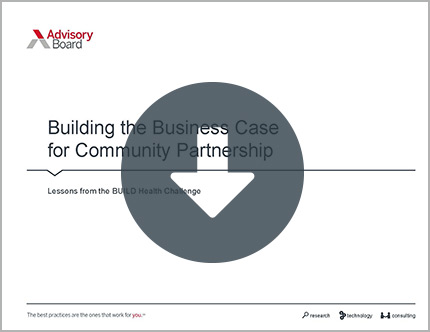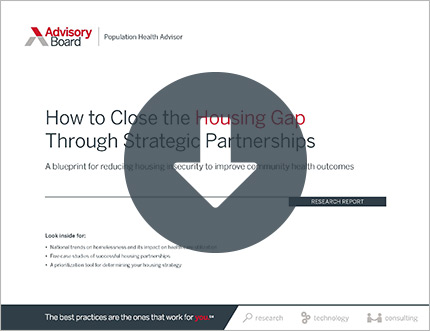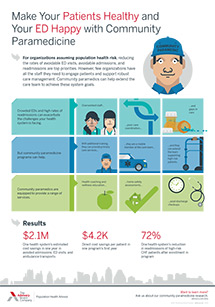Auto logout in seconds.
Continue LogoutWhile federally qualified health centers (FQHCs) and hospitals once served largely distinct populations, they're now frequently competing for the same patients—but some see the change as an opportunity for collaboration, Susannah Luthi reports for Modern Healthcare.
Make your patients healthy and your ED happy with community paramedicine
The rise of FQHCs
FQHCs "have become a sleeping giant in the health care industry," Luthi writes.
More than 1,400 FQHCs now operate at 10,000 sites nationwide, serving about 26 million individuals, according to Luthi. As the number of FQHCs increases, their business models also have evolved.
According to Luthi, in 1985, about 83% of FQHC revenue came from federal appropriations, while Medicaid made up 7% and Medicare 1%. But in 2015, federal appropriations accounted for just 18% of FQHC funding, while Medicaid made up 44%, Medicare 7%, and other sources—including commercial insurance—made up 19%, according to data from FQHC Germane, a consulting firm.
In addition, FQHCs increasingly offer ancillary services, such as lab work and imaging, that are also available at local hospitals.
Competing with hospitals
In many cases, those developments mean FQHCs are competing more with hospitals.
Tim Moore, president of the Mississippi Hospital Association, said he understands that FQHCs must compete for insured patients, but he said the competition is placing a strain on his members. "When hospitals, particularly small rural hospitals, are being strapped so hard for revenue, and you're trying to determine how to keep your doors open, if you lose any kind of service that brings revenue into the hospital, it's difficult, it exacerbates the problem," he said.
Luthi reports that "similar points of friction" have surfaced nationwide in conversations with hospital and community health officials.
One point of contention is the way that FQHCs are paid. The centers receive cost-based prospective payments, even if they're in a state that uses capitated Medicaid payments. In California, for instance, FQHCs are reimbursed for the difference between the managed care plans payment and the federal fee-for-service rate.
Michael Hochman, an assistant professor at the USC Keck School of Medicine, said the payments give FQHCs an advantage over hospitals.
Further, some say prospective payments foster poor care management practices for FQHC patients, such as overbooking. Michael Hochman, an assistant professor at the USC Keck School of Medicine, said, "With fee-for-service, it's all about getting the Medicaid patients." He added, "If patients are going elsewhere, that's less money for the FQHC."
That said, there are still FQHCs that operate in areas without other providers. And in states with high Medicaid populations but low Medicaid reimbursement, the prospective payment "is a lifesaver"—particularly in states that haven't expanded Medicaid, Luthi writes.
Some experts, including Hochman, say more FQHCs should embrace value-based care models. But Rachel Tobey, director of the research group John Snow, said, "Once you open the door for states to waive PPS protections, if you open it even a crack, you run the risk of driving important safety-net providers out of business."
Collaboration
While the changing payer mix at FQHCs has fed competition, it also has encouraged collaboration, as the federal government increasingly finds ways to reward providers for coordinating care, Luthi reports.
In Mississippi, Moore said, "We've tried to get away from competition and hit the restart button." He added, "Let's bring the FQHCs and rural hospitals together, let's work together and share the cost and expense, share the patients in order for physicians to come to Mississippi."
Last year, Moore assembled a coalition of FQHCs and hospitals to launch a residency program for a specialty care physician that no single rural provider could afford on its own. Moore said the initiative could grow to support resident clinicians across disciplines.
Similarly, Sakakawea Medical Center, a critical access hospital in rural North Dakota, started collaborating with an FQHC in 2011, when the FQHC lacked a CEO. It asked Derrold Bertsch, who already headed the hospital, to step in.
"Prior to 2011," Bertsch said, "there was a very competitive relationship between two organizations." But today, the organizations share some board members, and each facility avoids offering services that the other can perform better.
"It's incumbent upon rural FQHCs and critical-access hospitals and their leadership to develop those solutions," Bertsch said (Luthi, Modern Healthcare, 2/17).
Make your patients healthy and your ED happy with community paramedicine
For organizations assuming population health risk, top priorities include reducing the rates of avoidable ED visits, avoidable admissions, and readmissions. But most organizations don't have all the staff they need to engage patients and support robust care management.
Our infographic explains how community paramedics can help extend the care team to achieve these system goals.
Don't miss out on the latest Advisory Board insights
Create your free account to access 1 resource, including the latest research and webinars.
Want access without creating an account?
You have 1 free members-only resource remaining this month.
1 free members-only resources remaining
1 free members-only resources remaining
You've reached your limit of free insights
Become a member to access all of Advisory Board's resources, events, and experts
Never miss out on the latest innovative health care content tailored to you.
Benefits include:
You've reached your limit of free insights
Become a member to access all of Advisory Board's resources, events, and experts
Never miss out on the latest innovative health care content tailored to you.
Benefits include:
This content is available through your Curated Research partnership with Advisory Board. Click on ‘view this resource’ to read the full piece
Email ask@advisory.com to learn more
Click on ‘Become a Member’ to learn about the benefits of a Full-Access partnership with Advisory Board
Never miss out on the latest innovative health care content tailored to you.
Benefits Include:
This is for members only. Learn more.
Click on ‘Become a Member’ to learn about the benefits of a Full-Access partnership with Advisory Board
Never miss out on the latest innovative health care content tailored to you.



